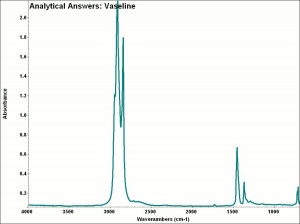Difference between revisions of "Vaseline"
Jump to navigation
Jump to search
| Line 2: | Line 2: | ||
[Unilever] A registered trademark for a translucent white, [[petrolatum|petroleum jelly]]. Vaseline® was first manufactured in 1870 by an English-born chemist Robert Chesebrough. It is composed of a mixture of aliphatic hydrocarbons ranging from about C15 to C20. Vaseline® is used as an ointment, [[lubricant|lubricant]], [[water%20repellent|water repellent]], [[release%20agent|release agent]], and temporary [[adhesive|adhesive]]. It is not recommended for contact with any art object. | [Unilever] A registered trademark for a translucent white, [[petrolatum|petroleum jelly]]. Vaseline® was first manufactured in 1870 by an English-born chemist Robert Chesebrough. It is composed of a mixture of aliphatic hydrocarbons ranging from about C15 to C20. Vaseline® is used as an ointment, [[lubricant|lubricant]], [[water%20repellent|water repellent]], [[release%20agent|release agent]], and temporary [[adhesive|adhesive]]. It is not recommended for contact with any art object. | ||
| − | + | [[[SliderGallery rightalign|aaiVASELINE.jpg~FTIR]]] | |
== Synonyms and Related Terms == | == Synonyms and Related Terms == | ||
petrolatum; petroleum jelly; mineral jelly; vaselina (Esp.) | petrolatum; petroleum jelly; mineral jelly; vaselina (Esp.) | ||
| − | [ | + | ==Risks== |
| − | + | * Sigma Aldrich: [https://www.sigmaaldrich.com/US/en/substance/vaseline123458009038 SDS] | |
| − | == | + | ==Physical and Chemical Properties== |
Soluble in benzene, turpentine and petroleum solvents. Insoluble in water. | Soluble in benzene, turpentine and petroleum solvents. Insoluble in water. | ||
| Line 16: | Line 16: | ||
|- | |- | ||
! scope="row"| Melting Point | ! scope="row"| Melting Point | ||
| − | | 40-50 | + | | 40-50 C |
|- | |- | ||
! scope="row"| Density | ! scope="row"| Density | ||
| − | | 0.820-0.865 | + | | 0.820-0.865 g/ml |
|} | |} | ||
| − | == | + | ==Resources and Citations== |
| − | |||
| − | |||
| − | + | * Unilever: [https://www.vaseline.com/us/en/products/healing-jelly.html Vaseline] | |
* G.S.Brady, ''Materials Handbook'', McGraw-Hill Book Co., New York, 1971 Comment: p. 594 | * G.S.Brady, ''Materials Handbook'', McGraw-Hill Book Co., New York, 1971 Comment: p. 594 | ||
| Line 34: | Line 32: | ||
* Random House, ''Webster's Encyclopedic Unabridged Dictionary of the English Language'', Grammercy Book, New York, 1997 | * Random House, ''Webster's Encyclopedic Unabridged Dictionary of the English Language'', Grammercy Book, New York, 1997 | ||
| − | * Website | + | * Website: www.lib.utexas.edu/lib/eng/timline/postmod/brands.html |
[[Category:Materials database]] | [[Category:Materials database]] | ||
Latest revision as of 15:47, 23 June 2022
Description
[Unilever] A registered trademark for a translucent white, petroleum jelly. Vaseline® was first manufactured in 1870 by an English-born chemist Robert Chesebrough. It is composed of a mixture of aliphatic hydrocarbons ranging from about C15 to C20. Vaseline® is used as an ointment, Lubricant, Water repellent, Release agent, and temporary Adhesive. It is not recommended for contact with any art object.
Synonyms and Related Terms
petrolatum; petroleum jelly; mineral jelly; vaselina (Esp.)
Risks
- Sigma Aldrich: SDS
Physical and Chemical Properties
Soluble in benzene, turpentine and petroleum solvents. Insoluble in water.
| Melting Point | 40-50 C |
|---|---|
| Density | 0.820-0.865 g/ml |
Resources and Citations
- Unilever: Vaseline
- G.S.Brady, Materials Handbook, McGraw-Hill Book Co., New York, 1971 Comment: p. 594
- Matt Roberts, Don Etherington, Bookbinding and the Conservation of Books: a Dictionary of Descriptive Terminology, U.S. Government Printing Office, Washington DC, 1982
- Random House, Webster's Encyclopedic Unabridged Dictionary of the English Language, Grammercy Book, New York, 1997
- Website: www.lib.utexas.edu/lib/eng/timline/postmod/brands.html
